Stalingrad: For 59 Days 30 Soviet Soldiers Were Under Siege In Pavlov’s House, They Never Surrendered
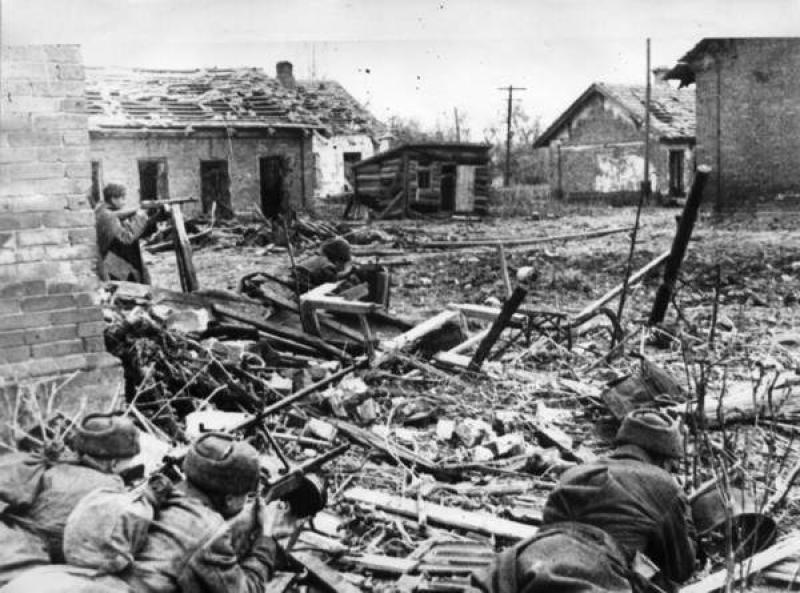

For six months one of the bloodiest battle is history took place in Russia. Stalingrad, the name alone conjures up sacrifice, courage and the never quit of the Russian army. Millions died in this battle, more Russian soldiers were killed at Stalingrad than the U.S. lost in the entire war.
75,000 Russian women fought here as snipers, pilots, gunners, medical personal. The ''Nightwitches'' of the Russian Air Force and the teenage girls that stopped the German Panzer attack using the anti aircraft guns where among them.
There was no lack of hero's. But inside of this horrific battle another battle was taking place. A little known junior Sargent and his thirty men did the impossible. This small force was made up of Russian, Mongols, Georgians and Jews. Truly a diverse group.
Sargent Yakov Pavolov and his men ''Stood Their Ground'' at what is know as ''Pavolov's House''...
This is their story.
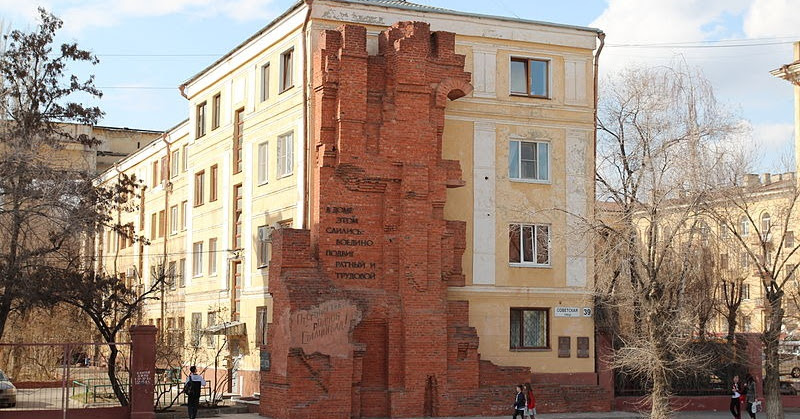 Insider CC BY-SA 3.0
Insider CC BY-SA 3.0| SHARE: Facebook Twitter |
The Battle of Stalingrad is one of the best-known battles of WWII. The siege of the city that lasted from 23rd of August, 1942 to the 2nd of February, 1943 saw several power shifts between confronting sides. The Soviets declared it their ultimate mission to withstand the Axis push at Stalingrad ― the city that bore the name of their leader, Joseph Stalin. Hitler saw the symbolic potential too and insisted on capturing the city, no matter the cost.
Street fights raged for months while snipers scanned the devastated landscape in search of any sign of life. Every house was a battleground. Apartment buildings were taken and lost by storm, in a matter of hours, even minutes. Life lost all value on the streets of Stalingrad as the Soviets believed in their superior numbers and pushed forward, losing hundreds of thousands of soldiers. On the strategic chessboard, those were days when it was all or nothing.
But outside the cozy headquarters from which Soviet and German generals directed the bloody play, men on both sides were losing their lives with every wrong step they made. And at Stalingrad, there were many “wrong steps.''
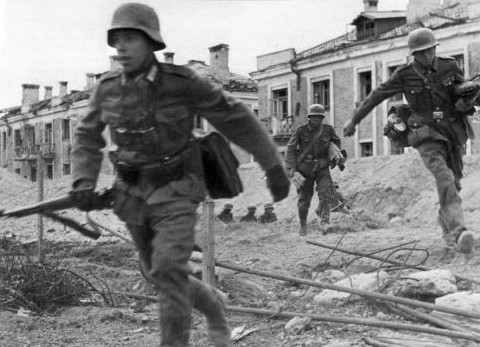 German Soldiers on the move in Stalingrad.
German Soldiers on the move in Stalingrad.Nevertheless, heroic deeds were done on the streets of Stalingrad and one of the most inspiring figures of the battle, who served as role-model to many Red Army soldiers during the war and afterward, was Seargent Yakov Pavlov.
Pavlov became well-known after he and his small platoon held on for 59 days against a numerically superior enemy in an apartment building in Stalingrad. The siege lasted from 27th September to 25th November 1942.
Born in a peasant family in northwestern Russia, Pavlov was drafted into the military life in 1938. At first, Pavlov was a Junior Seargent in charge of a machine gun squad and an artillery NCO. He became a leader of a reconnaissance platoon after all of the officers in his squad were killed in Stalingrad. The platoon acted as a vanguard, pushing the fragile edge of the front deep into enemy controlled territory.
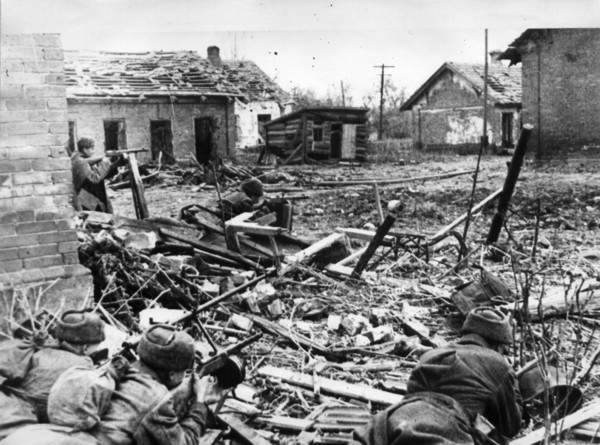 Soviet soldiers prepare to defend their position during the battle.
Soviet soldiers prepare to defend their position during the battle.On one such operation, Pavlov and his squad of 30 soldiers captured a four-story apartment building held by the Germans. The building, located near the Volga riverbank, was facing the 9th of January Square, which was named to honor the event dating from 1905 when a group of protesters were shot by the Russian Imperial Guard in St Petersburg. Pavlov’s men occupied and held the building, but the bulk of the Soviet army was still miles away, so they became stranded.
Pavlov received orders to hold the building. And he did with all of his heart for, at that time, the infamous Stalin’s Order 227 was put in effect. “Not one step Back” was the order and it became a slogan of defiance towards the Axis powers during the war. The controversial order did, in fact, have a decisive effect on many soldiers, for it was better to stand and fight than to be declared traitor and shot. So he fortified the apartment building and defended it to the last man and the last bullet.
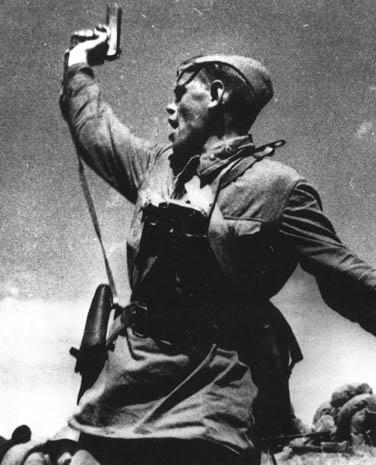 A Soviet junior political officer (Politruk) urges Soviet troops forward against German positions. By RIA novosti CC BY-SA 3.0
A Soviet junior political officer (Politruk) urges Soviet troops forward against German positions. By RIA novosti CC BY-SA 3.0The house had great strategic importance as its position at the crossroads gave its defenders an overview that stretched on for a kilometer on all sides.
With elements of the famed 13th Guard Rifle Division, he fortified the building, laying four lines of barbed wire. He mined the area and set up machine gun nests in the basement and the loft. An old anti-tank rifle was all Pavlov had against German Panzers. He mounted the AT rifle on the roof, where the tanks couldn’t elevate their turret enough to hit it. From this position his men were capable of piercing the thin armor on the turret, thus neutralizing the tanks. Using this tactic the Soviet defenders destroyed more than a dozen tanks. The attacks became more frequent. Each time the Germans attacked, they were repelled by a machine gun barrage from the basement, the windows, and the roof.
Supplies were scarce, and sleep was a luxury, as the Germans decided to shoot during the night to keep the defenders awake. As the siege dragged on, the building was dubbed Pavlov’s House, or more precisely Pavlov’s Home.
The fortified building was completely adapted for the purpose of repelling the attacking waves. One wall was breached to improve internal communication. A trench was dug as a lifeline to the Soviet troops outside. Pavlov’s men weren’t cut off from the rest of the army, but they still had to face a shortage of food and water, for the entire Red Army at the time lacked sufficient basic supplies. Also, the men had no beds, so the soldiers slept on insulation wool torn out of the walls. Some reinforcements managed to break through to the building, via the trench or the Volga river, but there was never more than a dozen defenders at any time of the siege.
After several attacks, corpses began to stack up on the square in front of the building. Allegedly, Pavlov’s men had to go out between battles and clear the square of bodies, for they were often used as cover by the attacking Germans.
During the 59-day siege, the building was inhabited by citizens who lived there before the battle. They were evacuated to the basement, where they lived until the Soviet Army relieved Pavlov’s squad on the 25th of November.
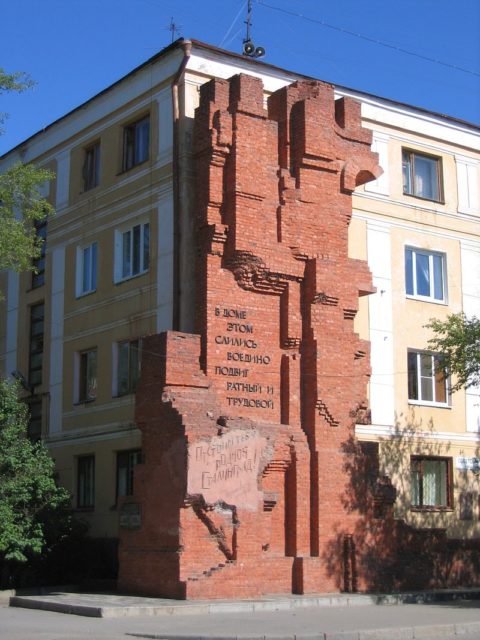 Pavlov’s House in its current state. The inscription on the memorial reads: “In this building heroic feats of warfare and of labor fused together. We will defend and rebuild you, dear Stalingrad!” By – Andrey Volykhov CC BY-SA 3.0
Pavlov’s House in its current state. The inscription on the memorial reads: “In this building heroic feats of warfare and of labor fused together. We will defend and rebuild you, dear Stalingrad!” By – Andrey Volykhov CC BY-SA 3.0The battle became a symbol of stubborn Soviet resistance during the Great Patriotic War. Only four men of the original platoon, including Pavlov, managed to pull through the siege and welcome the advancing Soviet troops. General Vasily Chuikov, who was in command of the Soviet Forces in Stalingrad, bragged how the Germans lost more troops at Pavlov’s House than they did conquering Paris.
Yakov Pavlov participated in the Battle of Berlin and survived the war with many medals. He was declared Hero of the Soviet Union in 1945. The house was rebuilt after the war, and a monument was erected out of old bricks from the original building.





A story that deserves to me told.
Absolutely. How often do we hear of such stories when the heroes were not Americans?
Agreed.
Thanks.
Another stirring story. Thanks, K.
"Stopped At Stalingrad" by Joel S.A. Hayward is another good read.
The Battle of Stalingrad sealed Germany's defeat. The German losses were just to much. My own summation is 'the German defeat at Stalingrad falls irrevocably on the hands of Adolf Hitler'. Hitler was a double speaking, big mouthed politician, but the worst military strategist in history. In short, he was a moron.
He was even a lousy painter.
Two coats.
No buttons.
It's an excellent read. When the Russians counter attacked and did not strike the center of the German line but the flank's and encircled General Paulus and his men it was over for the Germans. Paulus surrendered and the remaining 91,000 men were taken captive. Only 5 to 6 thousand ever returned to Germany.
Estimates are that the Germans and their allies lost as killed, wounded or captured close to 800,000 men.
If you don't have time to read it you can get a snippet of the battle for Stalingrad in the movie "Enemy at the Gates". It focuses on the sniper division but gives a pretty visceral feel for what they were likely going through.
I've watched it. It's been shown on TV here in China.
Fascinating story. I knew that the Russians held the Germans back at Stalingrad. I had no idea that it was this small group was strategic to the win. Thanks for finding this gem of a story with the cool photos, too. But now I will know the name Seargent Yakov Pavlov and his relevance at this time.
I saw "Enemy at the Gates" and thought it was really interesting. A good representation of this time.
Stalingrad was such a devastating defeat for the Germans that they never really recovered from it.
Most of the history of WWII is from an American perspective and of course it should be for us. But the contributions of other nations, especially Russia is not well known.
Commonly yes, most are only taught the free world side.....
But for over three years the Russians took the brunt of the German onslaught. and except for Hitler and his vanity, they may very well have been beaten.....
Stalingrad was a battle of vanity. Hitler wanted it simply cause of it's name. The Army Group "B"'s Drive on the Caucus oil fields was to eliminate them as a source of fuel for the Soviets. The Russians for the most part were on the east side of the Volga, the Germans on the west side except for the forces holding Stalingrad....
The plan of battle was to bypass Stalingrad and force the Russian withdrawal of the town by cutting it off.... The Russians on the other hand were trying to keep the tank works operating as long as possible before running out of supplies and withdrawing.
In a progress conference, Hitler saw that Army Group "B" was going to pass Stalingrad by as it was making good progress towards it's objectives against moderate Soviet resistance. The Russians under Generals Vasilevsky & Zhukov were tracking (following) Army Group "B" from the other side of the Volga waiting for the Germans to reveal their specific objective and to prevent them from turning east and crossing the river.....
Hitler felt that there was insufficient Russian forces for them to hold Stalingrad as he thought the Russians would have been forced to withdraw as Army Group "B" flanked the city.... He ordered VonPaulus to take the city once past it. Two days later Hitler got pissed that the 6th Army hadn't taken the city yet so directly ordered Von Paulus to stop what he was doing and take it immediately.... He also ordered the 4th Panzer Army to support him in taking the city.
Big miscalculation..... the Russians were not ready to pull out, they were still building tanks that they desperately needed and the German advance hadn't completely flanked the city yet so they were in no mind to leave..... General Voronov had almost a full division and supporting units in and around the city.
When Von Paulus changed his line of advance towards Stalingrad, (almost reversing his line of march) Zhukov recognized this as the moment he was waiting for and ordered his armies to turn left towards the river Vasilevsky 50mi to the north of the city and his own troops 50 miles to the south. He knew that the Germans were using their weaker allied troops to guard their left flank and the western approaches to Stalingrad. and that the 4th Panzer Army was dispersed amongst the units of the 6th army as assault support. Two days later as the 6th Army advance units reached the city, his two armies crossed the Volga and attacked the 6th Army on both flanks hard with tanks leading and artillery pounding the shoulders of the assault to freeze the Germans in positions.
Two days later the two attacks joined up some 55 miles to the east of Stalingrad and set up defenses in depth to prevent any counterattacks.
After that it was all over but the crying for the Germans, Army Group "B" continued on it's offensive towards the Caucasus, (severely weakened with the loss of the 6th Army and 4th Panzer Army guarding it's long left flank) but still under orders to take the Caucasus. They were unable to turn and support Von Paulus on the direct orders of Hitler himself.
Von Paulus refused to withdraw on the orders if Hitler against the strident requests of Von Manstein who (under direct orders from Hitler) was trying to open a corridor up to relieve them with elements of Army Group "Center". It was going to take the combined efforts of both Army Group's to extricate the 6th Army from the the jaws of the vise they were in.... But they could have done it....
Hitler refused..... He ordered the 6th Army to stand and fight in place.
So they lost the entire 6th Army, most of the 4th Panzer Army and Army Group "B" had to eventually withdraw from it's strategic advance into the Caucasus leaving the main Russian source of petroleum products in the enemy's hands....
It's was not only a bad tactical defeat, but an immensely massive strategic defeat also.....
The war turned right there. The Germans were never able to go on a major offensive again, each time they tried, the Soviets would counter with equal forces in piercing counterattacks backed by masses of tanks and artillery.....
November 23, 1942, The moment the Russian armies of Vasilevsky & Zhukov joined up at the little town of Kalach, WWII was decided.
It still took one hell of a lot of fighting and dying, but the tide was turned, 1942 was a bad year for the axis, El Alamein, Coral Sea & Midway, then Stalingrad.
Allied victory was inevitable.... and the Big Three knew it....